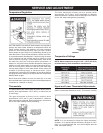
23
Start Up Conditions
THERMAL EXPANSION
Water supply systems may, because of such events as high
line pressure, frequent cut-offs, the effects of water hammer
among others, have installed devices such as pressure
reducing valves, check valves, back flow preventers, etc...to
control these types of problems. When these devices are not
equipped with an internal by-pass, and no other measures are
taken, the devices cause the water system to be closed. As
water is heated, it expands (thermal expansion) and closed
systems do not allow for the expansion of heated water.
The water within the water heater tank expands as it is heated
and increases the pressure of the water system. If the relieving
point of the water heater's temperature-pressure relief valve is
reached, the valve will relieve the excess pressure. The
temperature-pressure relief valve is not intended for the
constant relief of thermal expansion. This is an unacceptable
condition and must be corrected.
It is recommended that any devices installed which could create
a closed system have a by-pass and/or the system have an
expansion tank to relieve the pressure built by thermal
expansion in the water system. Thermal expansion tanks are
available from Sears stores and through the Sears Service
Centers. Contact the local plumbing inspector, water supplier
and/or the Sears Service Center for assistance in controlling
these situations.
Thermal Expansion Tank Specifications
Tank Dimensions Pipe
Model Capacity
in Inches Fitting
Number In Gallons Diameter Length On Tank
153.331020 2 8 (203 mm) 12-3/4 (323 mm) 3/4” Male
153.331050 5 11 (279 mm) 14-3/4 (375 mm) 3/4” Male
Expansion Tank Sizing Chart
Inlet* Water Heater Capacity (Gallons)
Water
Pressure 30 40 50 66 82
Expansion 40psi 2 2 2 5 5
Tank 50psi 2 2 2 5 5
Capacity 60psi 2 2 5 5 5
Needed 70psi 2 2 5 5 5
80psi 2 5 5 5 5
*Highest recorded inlet water pressure in a 24 hour period or
regulated water pressure.
NOTE: Expansion tanks are pre-charged with a 40 psi air
charge. If the inlet water pressure is higher than 40 psi, the
expansion tank’s air pressure must be adjusted to match
that pressure, but must not be higher than 80 psi.
FIGURE 43.
STRANGE SOUNDS
Possible noises due to expansion and contraction of some
metal parts during periods of heat-up and cool-down do not
represent harmful or dangerous conditions.
Operational Conditions
SMELLY WATER
In each glass-lined water heater there is installed one anode
rod (see parts section) for corrosion protection of the tank.
Certain water conditions will cause a reaction between this
rod and the water. The most common complaint associated
with the anode rod is one of a “rotten egg smell”. This odor is
derived from hydrogen sulfide gas dissolved in the water. The
smell is the result of four factors which must all be present for
the odor to develop:
A. A concentration of sulfate in the supply water.
B. Little or no dissolved oxygen in the water.
C. A sulfate reducing bacteria within the water heater. (This
harmless bacteria is non-toxic to humans.)
TROUBLESHOOTING


















